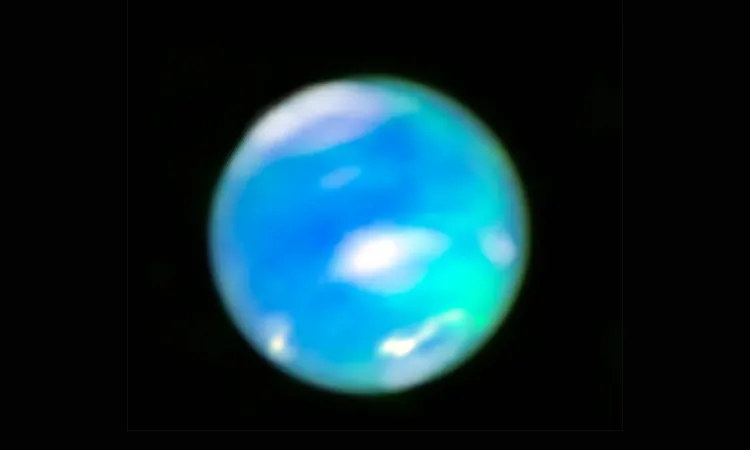
Stunning Discovery: First Ever Images of Neptune's Auroras Captured by James Webb Space Telescope!
2025-03-30
Author: William
For the very first time, Neptune’s mesmerizing auroras have transitioned from theories to vivid reality, thanks to the groundbreaking advancements of NASA's James Webb Space Telescope (JWST). Astronomers have unveiled spectacular images that showcase auroral activity illuminating the upper atmosphere of this distant planet.
The findings reveal energetic solar particles colliding with Neptune's ionosphere, producing a stunning brightly colored signature. These particles often originate from the Sun, traveling through magnetic fields before interacting with Neptune’s atmosphere. This high-energy dance generates the brilliant emissions captured in Webb’s near-infrared imagery.
While astronomers have previously observed auroral phenomena on other gas giants such as Jupiter, Saturn, and Uranus, Neptune's incredible light shows had long eluded detection.
A New Era of Discovery: Neptune's Secrets Unveiled
NASA's Voyager 2 spacecraft first hinted at the existence of auroras on Neptune during its flyby in 1989; however, subsequent observations failed to confirm their presence until now. "Actually imaging the auroral activity on Neptune was only possible with Webb’s near-infrared sensitivity," remarked lead researcher Henrik Melin from Northumbria University. He expressed his amazement at the level of detail obtained from the images, stating he was "stunned" by the clarity of the auroras.
In June 2023, the James Webb Space Telescope utilized its Near-Infrared Spectrograph to capture these remarkable images. The data collected not only illustrates the auroras but also allows scientists to analyze the planet’s atmospheric temperature and chemical composition.
For the first time, researchers observed a significant emission line from the molecule H3+, a compound formed during auroras, which appeared as cyan-colored patches in the images. H3+ serves as a crucial marker for auroral activity across gas giants, and until now, its presence on Neptune remained speculative.
Understanding Neptune's Unique Magnetic Field
Unlike Earth's polar auroras, those on Neptune are typically found in mid-latitude regions. If we were to translate this to Earth, it would mean auroral displays occurring above regions like South America! The unique positioning arises from Neptune's magnetic field, which Voyager 2 discovered to be tilted 47 degrees from the planet’s rotational axis. This tilt alters where magnetic field lines converge, shifting auroras far from conventional polar zones and complicating our understanding of Neptune's space weather.
An Unexpectedly Cool Upper Atmosphere
Additionally, Webb’s data indicates an unexpected cooling trend in Neptune’s upper atmosphere since 1989. Melin noted that the atmospheric temperature has decreased by several hundred degrees, with the 2023 readings just over half of what they were in 1989. This significant temperature drop could explain why Neptune's spectacular auroras went undetected for such a long time, as colder atmospheres can reduce auroral brightness.
The findings suggest that Neptune possesses a dynamic upper atmosphere capable of substantial temperature fluctuations, even at its vast distance of 30 astronomical units from the Sun.
Looking Forward: Future Exploration of Ice Giants
These revelations represent a pioneering moment in the study of ice giants and pave the way for future missions. Scientifically, there are plans to monitor Neptune throughout an entire solar cycle, approximately eleven years, to enhance our understanding of how solar activity impacts its magnetic field and atmosphere.
"As we envision future missions to Uranus and Neptune, the need for instruments capable of capturing infrared light will be paramount for studying auroras," pointed out Leigh Fletcher from Leicester University. "This observatory has opened the door to a previously hidden view of the outer worlds of our solar system."
This groundbreaking research has been published in *Nature Astronomy*, establishing new pathways to explore the enigmatic secrets of our solar system.
Stay informed with our newsletter for the latest cosmic discoveries and groundbreaking astronomical research!









 Brasil (PT)
Brasil (PT)
 Canada (EN)
Canada (EN)
 Chile (ES)
Chile (ES)
 Česko (CS)
Česko (CS)
 대한민국 (KO)
대한민국 (KO)
 España (ES)
España (ES)
 France (FR)
France (FR)
 Hong Kong (EN)
Hong Kong (EN)
 Italia (IT)
Italia (IT)
 日本 (JA)
日本 (JA)
 Magyarország (HU)
Magyarország (HU)
 Norge (NO)
Norge (NO)
 Polska (PL)
Polska (PL)
 Schweiz (DE)
Schweiz (DE)
 Singapore (EN)
Singapore (EN)
 Sverige (SV)
Sverige (SV)
 Suomi (FI)
Suomi (FI)
 Türkiye (TR)
Türkiye (TR)
 الإمارات العربية المتحدة (AR)
الإمارات العربية المتحدة (AR)